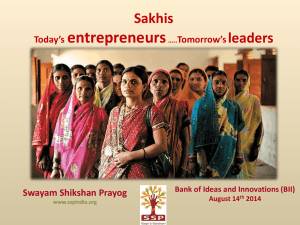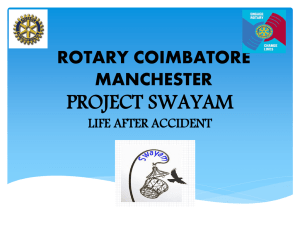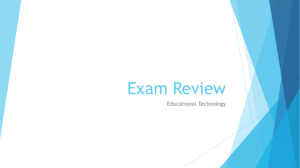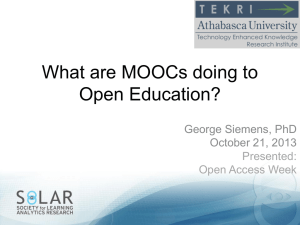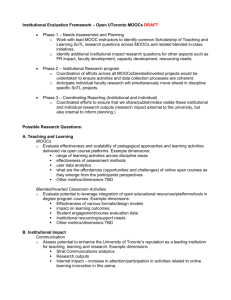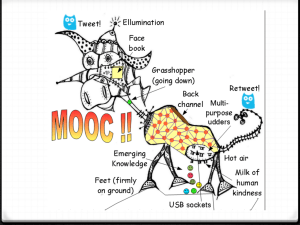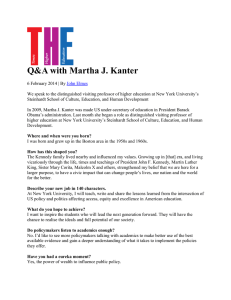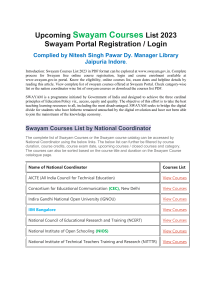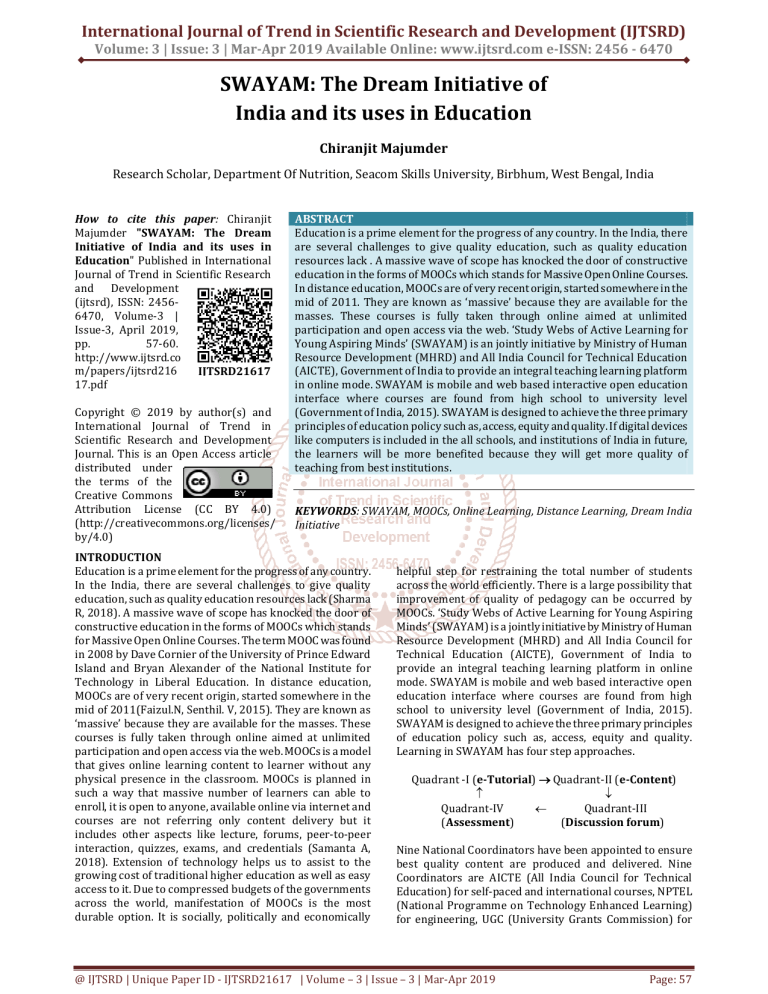
International Journal of Trend in Scientific Research and Development (IJTSRD) Volume: 3 | Issue: 3 | Mar-Apr 2019 Available Online: www.ijtsrd.com e-ISSN: 2456 - 6470 SWAYAM: The Dream Initiative of India and its uses in Education Chiranjit Majumder Research Scholar, Department Of Nutrition, Seacom Skills University, Birbhum, West Bengal, India How to cite this paper: Chiranjit Majumder "SWAYAM: The Dream Initiative of India and its uses in Education" Published in International Journal of Trend in Scientific Research and Development (ijtsrd), ISSN: 24566470, Volume-3 | Issue-3, April 2019, pp. 57-60. http://www.ijtsrd.co m/papers/ijtsrd216 IJTSRD21617 17.pdf Copyright © 2019 by author(s) and International Journal of Trend in Scientific Research and Development Journal. This is an Open Access article distributed under the terms of the Creative Commons Attribution License (CC BY 4.0) (http://creativecommons.org/licenses/ by/4.0) ABSTRACT Education is a prime element for the progress of any country. In the India, there are several challenges to give quality education, such as quality education resources lack . A massive wave of scope has knocked the door of constructive education in the forms of MOOCs which stands for Massive Open Online Courses. In distance education, MOOCs are of very recent origin, started somewhere in the mid of 2011. They are known as ‘massive’ because they are available for the masses. These courses is fully taken through online aimed at unlimited participation and open access via the web. ‘Study Webs of Active Learning for Young Aspiring Minds’ (SWAYAM) is an jointly initiative by Ministry of Human Resource Development (MHRD) and All India Council for Technical Education (AICTE), Government of India to provide an integral teaching learning platform in online mode. SWAYAM is mobile and web based interactive open education interface where courses are found from high school to university level (Government of India, 2015). SWAYAM is designed to achieve the three primary principles of education policy such as, access, equity and quality. If digital devices like computers is included in the all schools, and institutions of India in future, the learners will be more benefited because they will get more quality of teaching from best institutions. KEYWORDS: SWAYAM, MOOCs, Online Learning, Distance Learning, Dream India Initiative INTRODUCTION Education is a prime element for the progress of any country. In the India, there are several challenges to give quality education, such as quality education resources lack (Sharma R, 2018). A massive wave of scope has knocked the door of constructive education in the forms of MOOCs which stands for Massive Open Online Courses. The term MOOC was found in 2008 by Dave Cornier of the University of Prince Edward Island and Bryan Alexander of the National Institute for Technology in Liberal Education. In distance education, MOOCs are of very recent origin, started somewhere in the mid of 2011(Faizul.N, Senthil. V, 2015). They are known as ‘massive’ because they are available for the masses. These courses is fully taken through online aimed at unlimited participation and open access via the web. MOOCs is a model that gives online learning content to learner without any physical presence in the classroom. MOOCs is planned in such a way that massive number of learners can able to enroll, it is open to anyone, available online via internet and courses are not referring only content delivery but it includes other aspects like lecture, forums, peer-to-peer interaction, quizzes, exams, and credentials (Samanta A, 2018). Extension of technology helps us to assist to the growing cost of traditional higher education as well as easy access to it. Due to compressed budgets of the governments across the world, manifestation of MOOCs is the most durable option. It is socially, politically and economically helpful step for restraining the total number of students across the world efficiently. There is a large possibility that improvement of quality of pedagogy can be occurred by MOOCs. ‘Study Webs of Active Learning for Young Aspiring Minds’ (SWAYAM) is a jointly initiative by Ministry of Human Resource Development (MHRD) and All India Council for Technical Education (AICTE), Government of India to provide an integral teaching learning platform in online mode. SWAYAM is mobile and web based interactive open education interface where courses are found from high school to university level (Government of India, 2015). SWAYAM is designed to achieve the three primary principles of education policy such as, access, equity and quality. Learning in SWAYAM has four step approaches. Quadrant -I (e-Tutorial) → Quadrant-II (e-Content) ↑ ↓ Quadrant-IV ← Quadrant-III (Assessment) (Discussion forum) Nine National Coordinators have been appointed to ensure best quality content are produced and delivered. Nine Coordinators are AICTE (All India Council for Technical Education) for self-paced and international courses, NPTEL (National Programme on Technology Enhanced Learning) for engineering, UGC (University Grants Commission) for @ IJTSRD | Unique Paper ID - IJTSRD21617 | Volume – 3 | Issue – 3 | Mar-Apr 2019 Page: 57 International Journal of Trend in Scientific Research and Development (IJTSRD) @ www.ijtsrd.com eISSN: 2456-6470 non technical post-graduation education, CEC (Consortium for Educational Communication)for under-graduate education, NCERT (National Council of Educational Research AndTraining) & NIOS (National Institute of Open Schooling) for school education, IGNOU (Indira Gandhi National Open University) for out of school students, IIMB (Indian Institute of Management, Bangalore) for management studies and NITTTR ( National Institute of Technical Teachers Training and Research) for Teacher Training programme. The courses that is delivered through SWAYAM are available free of cost to the learners. It students wants certificate, certificate is offered after successful completion of course with a little fee. At the end of the course, assessment of students through examination is taken and marks/grades secured in this exam could be transferred to the academic record of the students. SWAYAM would be ultimately capable of hosting 2000 courses and 80000 hours of learning-covering school, under-graduate, post-graduate, engineering, law and other professional courses. MOOCs The full form of MOOCs is ‘massive open online courses’ that is popular in western world. Now, many Indian’s are interested to MOOCs. Many Indian’s are also using this platform for their technology and skill enhancement in all the areas. The most of the MOOCs courses are purposed for unlimited participation and open access via the web. There is no boundaries to share the knowledge. The term MOOCs was raised in 2008 by Dave Cornier of the University of Prince Edward Island and Bryan Alexander of the National Institute for Technology in Liberal Education (Hiremath R, 2017). A ‘massive open online course’ (MOOC) is an online course purposed at unlimited participation and open access via the web. As the name itself reveals the MOOC is, Massive – This word means the targeted individuals are in large numbers. Any persons can get registered themselves anytime with or without any educational background and start learning. Online – The courses are available in online and is accessed anywhere and anytime with free of cost. Courses – There are many courses that are available in MOOCs and anyone anytime can take this courses with any education field. Different types of courses are offered under MOOCs. The most popular MOOCs providers are edX, cousera, Udacity, etc. edX is the one of the popular massive open online course (MOOC) provider. edX hosts university level courses through online in a wide range for the worldwide learner. edX do not take any charge on some courses. Another online learning platform is Cousera founded by Stanford University professors Andrew Ng and Daphne Koller. Cousera offers courses, degrees and specializations. In other side, Udacity is an online education provider that mainly focuses on job related online courses. Udacity offers various nanodegree programs on data science, machine learning, android, iOS, and many more. SWAYAM The full form of SWAYAM is ‘Study Webs of Active Learning for Young Aspiring Minds’. The SWAYAM is a digital platform developed by Ministry of Human Resource Development (MHRD) and All India Council for Technical Education (AICTE), Government of India with the help of Microsoft. SWAYAM is designed to accomplish the three most primary principles of Education policy like access, equity and quality (All India Council for Technical Education, 2017). The objective of creating SWAYAM is to take the best teaching learning resources to all including the most disadvantaged group. This platform is intended to host about 2000 courses 80000 hours of learning materials within 2 to 3 years on SWAYAM: covering maximum numbers of courses like school, under-graduate, post-graduate, engineering, law and other professional courses (Ministry of Human Resource Development, 2017). The courses hosted on SWAYAM are displayed in 4 quadrants. Open – The courses offered are open to everyone without any geographical boundaries. Four quadrants of SWAYAM are described in following below table. Table 1: Four Quadrants of SWAYAM Quadrant-I: e-Tutorial: lecture by video (using audio-video, multi-media, animation). Quadrant-II: e-Text: Specially prepared reading materials (PDF, Text, e-Books illustrations, presentation, related links, research papers, articles) that is downloaded. SWAYAM (Quadrants) Quadrant –III: Discussion forum: Arranged for raising doubts and clarifying them by Course Coordinator or his/her team. Quadrant –IV : Self-assessment Tests: It contains problems and solutions that is in the form of Multiple Choice Questions, Fill in the blanks, Matching Questions, Short Questions, Long Questions, Quizzes, Assignments and solutions, Frequently Asked Questions (FAQs) and providing clarifications on misconception of any topic, Nine National Coordinators have been appointed to ensure best quality content are produced and delivered. @ IJTSRD | Unique Paper ID - IJTSRD21617 | Volume – 3 | Issue – 3 | Mar-Apr 2019 Page: 58 International Journal of Trend in Scientific Research and Development (IJTSRD) @ www.ijtsrd.com eISSN: 2456-6470 Table 2: Nine Coordinators involved in SWAYAM SWAYAM Coordinators School Education ( I ) National Institute of Open Schooling ( II ) National Council of Educational Research and Training Out-of- school education ( III ) Indira Gandhi National Open University (IGNOU) Under-graduate education ( IV ) Engineering education (National Programme on Technology Enhanced Learning) Post-graduate education ( IV ) Engineering education (National Programme on Technology Enhanced Learning) ( V ) Management education (Indian Institute of Management, Bangalore) ( V ) Management education (Indian Institute of Management, Bangalore) ( VI ) Consortium for Educational Communication ( VII ) University Grants Commission (UGC) UGC and AICTE have revealed ‘Credit Framework for learning courses in online through SWAYAM, Regulation 2016’. UGC adviced to the University to identify courses where credits can be transferred on to the record of academic of the students for courses done on SWAYAM. 1. 2. 3. SWAYAM Android Mobile App/Google Play/IOS Availability of SWAYAM is through Android Mobile App/Google Play/IOS (iPhone Operating System) that can be downloaded by anyone who aspiring to pursue studies through MOOCs and can get registered as a learner or a student for any course starting from standard 9th till postgraduation (All India Council for Technical Education, 2017). Range of SWAYAM According to Government of India (Department of Higher Education, Ministry of Human Resource Development, 2015) SWAYAM cover the following below disciplines (Hiremath R, 2017). A. Curriculam based course contents covers various disciplines like arts, science, commerce, performing arts, social sciences and humanities subjects, engineering, technology, law, medicine, agriculture etc. in higher education sectors (all courses offers certificate also). B. SWAYAM offers school education modules for teacher training as well as teaching and learning assistances to children of India and try to help them understand the subjects and subjects matter better and also boost them in better preparedness for competitive examinations for admissions to professional degree programmes. C. Skills based courses are also in SWAYAM that helps the students specially after higher secondary examination. It specially helps the polytechnics students and it prepare the learners for working in industry. D. UGC adviced to the University to identify courses where credits can be transferred on to the record of academic of the students for courses done on SWAYAM. E. Curriculam and courses that can meet the needs of learners of Indian citizens in India specially and in abroad. Advantages of SWAYAM Following below points mentions about the some advantages of using SWAYAM by Indian learners. 4. 5. 6. Teacher Training Programme Self-paced ( VIII ) NITTTR ( National Institute of Technical Teachers Training and Research) ( IX ) AICTE (All India Council for Technical Education) For any Indian learner, SWAYAM is absolutely free of cost for learning but some fees is applied in case of certificate. The SWAYAM is a new platform to Indian learner that is complimentary to formal education in India. The learners who are in Indian University and institutions can not get quality teachers but SWAYAM is a platform by which any of the learners can get easily attached with the best teachers like the teacher of IITs, IIMs etc. The courses will attached to the skill India program. It is the very good platform because anyone can registered and can study through SWAYAM that means opportunity is being given to everyone. The high quality education will reach to the everyone at minimum cost and endeavor by the government of India. Challenges The main challenge of organizing ‘Massive Open Online Courses’ (MOOCs) in India for school education is the infrastructural problem. Some of the other challenges are also given below (Matliwala K, 2017): A. ‘Massive Open Online Courses' (MOOCs) demand digital literacy: The biggest challenge is to train the instructor. B. Problem in real time answering during lecture: Answer of any question can not be given instantly during the lecture time because it is the pre-recorded session. C. Believing on Multimedia Content: This the another problem which the user faces. Entire courses are offered through online only. Both lecturer and students have to rely on multimedia content. This course comprises presentations, audio and video lectures etc., all are these through online medium. Not every students are capable to use the online platform efficiently. D. Assessment / Examination: Currently only possible way to assess the progress of learner or students is Multiple choice based questions. Summary and Conclusion SWAYAM is a digital platform by which any one can easily register and study in anytime. It is very cost effective way of learning. It will be benefitted specially those students living in village area or disadvantaged group who do not get quality teaching. But one problem is still now in many villages in India, that is, their low economic condition. For @ IJTSRD | Unique Paper ID - IJTSRD21617 | Volume – 3 | Issue – 3 | Mar-Apr 2019 Page: 59 International Journal of Trend in Scientific Research and Development (IJTSRD) @ www.ijtsrd.com eISSN: 2456-6470 the lower economic condition, they can not buy the digital device like mobile phone, computer etc. According to me, if digital devices like computers is included in the all schools, colleges and universities of India, the learners or students will be more benefited because they will get more quality teaching from best institutions. One thing that I observed to write this review is that learning through SWAYAM, is very good initiative that started by Government of India and it will be more beneficial for future generation. MOOCs are the future solution of today’s distance learning through the platform like SWAYAM in India. Future Scope The present study shows that ‘Massive Open Online Courses’ (MOOCs) through platform like SWAYAM (Study Webs of Active Learning for Young Aspiring Minds) is a very good jointly initiative by Ministry of Human Resource Development (MHRD) and All India Council for Technical Education (AICTE), Government of India to provide an integral teaching learning platform in online mode. SWAYAM is very new to all of the learners or persons in India. So, research is needed to observe the acceptance of this platform by Indian learners and citizens. Research is needed on the handling the digital devices among peoples in India and how many people have this digital devices like mobile phone and computer. Acknowledgements I, express my sincere gratitude to all the contributors of this paper. Special thanks to all the authors of the papers mentioned below in reference list. References [1] All India Council for Technical Education, (2017), SWAYAM an Unique Platform for Online Education in India, New Delhi: Government of India. [2] Faizul.N, Senthil. V, (2015), MOOCs: Changing Trend Towards Open Distance Learning with Special Reference to India, Journal of Library & Information Technology, 35(2)82-89. [3] Hiremath R, (2017), SWAYAM: The dream of India MOOC, International Journal of Advance Research and Innovative Ideas in Education, 2(3)242-247. [4] Matliwala K, (2017), SWAYAM- A Way of Learning, International Journal of Engineering Technology, Management and Applied Sciences, 5(4)359-362. [5] Ministry of Human Resource Development, (2017), SWAYAM, Government of India. [6] Samanta A, (2018), Analytical Study of SWAYAM, International Journal of Research and Analytical Reviews, 5(3)1374-1379. [7] Sharma R, (2018), Combining MOOCs with Social Media: An effective way of imparting LIS education in India, IFLA WLIC, 1-14. @ IJTSRD | Unique Paper ID - IJTSRD21617 | Volume – 3 | Issue – 3 | Mar-Apr 2019 Page: 60
